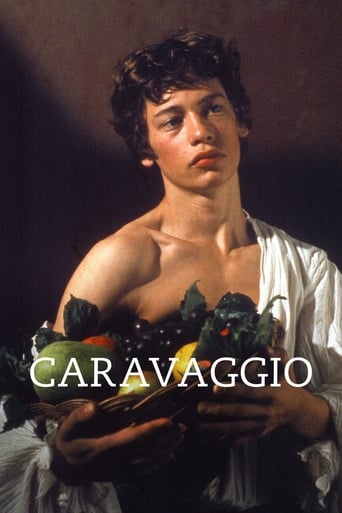lasttimeisaw
To celebrate my first encounter with Jerman's work, an encouraging 8 out 10 is a steadfast testament. For an experimental and aesthetic essay which occasions a fiery contention concerning the fashioning of art and human's innate struggle for desire, CARAVAGGIO is the perfect standard-bearer in the field.There are many merits from the film I can recapitulate, firstly, the recreation of Caravaggio's oeuvre is thrillingly overwhelming and a chief accomplishment is the starkly austere setting (a Silver Berlin Bear for its visual shaping that year is the most cogent proof for both), constituting a cocktail of the simplicity from the mundane world and the inexplicable lust from the spiritual concussion. Secondly, a theatrically radical group of thespians manages to embroider the no-frills narrative, which has been dispatched into several erratic episodes, with some passionately innovative punch, name checking the very young and rookie couple Sean Bean (smoking hot!) and Tilda Swinton (for whom this film is her debut), and as the titled genius, Nigel Terry resembles a doppelgänger image of the artist, while relentlessly contributing a scorching destructive epidemic to the character itself. Other small roles, such as Jack Birkett's Pope, Robbie Coltrane's Scipione Borghese and Dexter Fletcher's younger Caravaggio are all surrealistically wacky. Thirdly, the film is far from a biographical recount, a downright English accent and many deliberate anachronisms (smoking, typewriter e.g.) are contrived to amplify the zany flare to its cult hut, a phantasmagorical interpretation of the artist's ill-fated life. Clearly the film could be pigeonholed into a love-it-or-hate-it category like other non- mainstream films from genuine auteurs, and this time, my gut-feeling is being exaltedly dumbfounded.
Graham Greene
Quite simply unlike any other biographical film you will ever see, Derek Jarman's acclaimed production of Caravaggio (1986) is a lovingly constructed, highly personal cross-reference of tormented sixteenth century genius, twentieth century iconography and a somewhat satire on the shallowness of the burgeoning eighties' art scene of which Jarman was very much part of. Exploring Caravaggio's life through his work, the film distinctively merges fact, fiction, legend and imagination in a bold and confident approach that will probably leave serious art enthusiasts and casual viewers outraged by the complete disregard for accurate, historical storytelling.Shot with a typically avant-garde approach, director/writer Jarman doesn't so much fashion a biography of the artist, but rather, creates a personal reflection of the man using intimate characteristics that appeal to his film-making sensibilities. This makes Caravaggio more of an interpretation of the filmmaker than the artist himself; somewhat self-indulgently focusing on Caravaggio's struggle with bisexuality, perfectionism and wanton obsession; perhaps even glossing over the more intricate workings of the character, for instance, his own passion for art and his battles with the various religious and creative constraints of the period.It's a shame some of these ideas aren't further elaborated upon, because, at its heart, Caravaggio is really an exceptional film. As I commented earlier, it's perhaps unlike any other film you will ever see; an iconoclastic vision with a cinematic imagination that knows no bounds. Caravaggio is a film in which a 16th century setting gives way to the various anachronisms of passing trains, tuxedos, motorbikes, typewriters and chic nightclub settings. It is a film in which every frame is rendered in reference to the artist's work, composed with rich, shadowy colours that bring to mind the contrast between fresh and rotting fruit, and an unrivalled interplay between sound and production design that is reminiscent in its intense savagery of two dogs angrily ripping each other to pieces.There is no other 'based on fact film' that has demonstrated such a wild and evocative recreation of real-life hysteria and events, with the possible exception of Peter Jackson's masterful Heavenly Creatures (1994) or even some of Jarman's subsequent projects like Edward II (1991) and Wittgenstein (1994). With a cast of now very well known faces, such as Nigel Terry, Sean Bean, Tilda Swinton, Michael Gough, Dexter Fletcher and Robbie Coltrane - not to mention some of the most beautiful photography ever committed to film - Caravaggio represents an impressive and enjoyable combination of art and cinema that is now, twenty years on, ripe for rediscovery.
Galder-Sang
What we know of the life of Caravaggio is unfortunately incredibly limited. The narrative of this film does not really reflect that limited knowledge. From the disjunctive remains of one of the most important figures of all western art A narrative has been formed. The merits of this narrative are debatable and ultimately unimportant. The overwhelming strength of this film lies in the superb cinematography and the incorporation of Caravaggio's artwork into the film. Light emanates from an off screen point, bathing the shot in chiaruscuro lighting that was so signature of his work. The color of the film could be taken from his palate directly. Best of all was when his paintings were played out by the actors. The result is no less than a visually stunning presentation.
moviefarie
This beautiful visionary art film based on the director's take of the life of Caravaggio was worth the almost 7 years it took to make it. Derek Jarman had the brilliant sense to use Nigel Terry and Sean Bean as the lovers in this meditation on sexuality, criminality and art. This film is more of a fictionalization on Caravaggio using the artist's works as a way to pursue the story of the artist. It is beautiful, as are the actors and actresses, and Sean Bean is a revelation in this very early role, as he plays Ranucio, the love interest of Caravaggio. When he is on screen he steals the movie, as his animal magnetism, sexual energy, and wild persona grip the film and propel the story forward. This is an adult film with homosexual themes and might not be for everyone, but if one is adult and has a sense of taste, and loves art movies, this is a 10 out of 10.






